Summary
Copper One Penny Token, minted by Thomas Stokes, Melbourne. Issued by Murray & Christie, Castlemaine, 1862. In 1857 Murray joined Christie's business as a salesman. In 1861 they built another more substantial building on the same site. Unfortunately for them, when business slowed in Castlemaine in 1865 they had invested in the town heavily, purchasing a flour mill. They speculated in a range of pastoral, mining and property investments, all to their loss. David Murray became insolvent in 1871. Both men left Castlemaine in 1875, having speculated without much gain.
Physical Description
A round copper token (34 mm diameter). The token features the business of the issue Murray and Christie, Castlemaine: grocers, ironmongers, china and glassware merchants. It is combined with a Stokes Arms stock reverse: Coat of arms consisting of a central shield set on grass covered ground and below Rising Sun. On left a kangaroo seated facing out but head back towards sun (sejant sinister reguardant) and on right emu with similar stance (passant dexter reguardant). Below ground line and set on bouquet of rose, thistles and shamrock, a ribbon with the motto ADVANCE VICTORIA. The shield is quartered by a cross with a star at the centre and at the end of each arm. The cross is not shaded. The quarters contain: top left, a three-masted sailing ship; top right, a golden fleece; bottom left, an anchor; and bottom right, a wheat sheaf. Around above, VICTORIA . 1862 around below in two lines, T. STOKES MAKER / 100 COLLINS ST. EAST MELBOURNE. The neck of the emu is poorly engraved with additional line to the left, the T of EAST is below the letters AK of MAKER.
Obverse Description
Legend in five straight lines, GROCERS / IRONMONGERS / CHINA & GLASS / WARE / MERCHANTS This is one of two froms of this type, on this the letter R of GROCERS is above the space between the letters GE of IRONMONGERS. Border of 114 beads
Reverse Description
Coat of arms consisting of a central shield set on grass covered ground and below Rising Sun. On left a kangaroo seated facing out but head back towards sun (sejant sinister reguardant) and on right emu with similar stance (passant dexter reguardant). Below ground line and set on bouquet of rose, thistles and shamrock, a ribbon with the motto ADVANCE VICTORIA. The shield is quartered by a cross with a star at the centre and at the end of each arm. The cross is not shaded. The quarters contain: top left, a three-masted sailing ship; top right, a golden fleece; bottom left, an anchor; and bottom right, a wheat sheaf. Around above, VICTORIA . 1862 around below in two lines, T. STOKES MAKER / 100 COLLINS ST. EAST MELBOURNE. The neck of the emu is poorly engraved with additional line to the left, the T of EAST is below the letters AK of MAKER.
Edge Description
Plain
More Information
-
Collection Names
-
Collecting Areas
-
Acquisition Information
Transfer from National Gallery of Victoria (NGV), Mr Alfred Chitty, 15 Mar 1976
-
Date Issued
1862 AD
-
Issued By
-
Mint
Stokes (Mint), Melbourne, Greater Melbourne, Victoria, Australia, 1862
-
Previous Collection
-
Inscriptions
Obverse: GROCERS IRONMONGERS CHINA & GLASS WARE MERCHANTS Reverse: T. STOKES MAKER 100 COLLINS ST. EAST MELBOURNE ADVANCE VICTORIA
-
Denomination
-
Series
-
Material
Copper
-
Axis
12
-
Classification
-
Category
-
Discipline
-
Type of item
-
Dimensions
34 mm (Outside Diameter), 15.078 g (Weight)
-
Shape
Round
-
References
The company of Murray and Christie arranged with Stokes for the manufacture of their trade tokens in 1862. There was some trouble with both the obverse and reverse dies during the production. The first reverse die cracked and was replaced, with the two dies being identified in standard catalogues by the small differences in the relative positions of the lettering, a simple test involves the length of the word GROCERS and the postion of the letter R in GROCERS above the letters in the word IRONMONGERS: Die GROCERS R ABOVE 1 20.5 mm GE 2 19.4 G The obverse die is in the museum collection (NU 35771) as is Reverse 2 (NU 35772). Although the working face of the obverse is undamaged the main body of the die is surrounded by a series of deep indentations apparently made while trying to fix the die in the press. This is the only die in the collection so damaged and suggests that the steel was soft. This could explain the existance of the trade tokens made with Reverse 2 and Stokes stock die (Sharples Arms 6 = Heyde Arms 5), it may have become impossible to clamp the obverse die in the press so the order was filled with a stock die - the use of two reverses creating a trade token without the issuers name.
[Book] Andrews, Arthur. 1921. Australasian Tokens and Coins., No. 397
[Book] Heyde, Gilbert C. & Skinner, Dion H. 1967. Unofficial Coins of Colonial Australia and New Zealand., No. 192/1
[Article] Sharples, John P. 1993. A Catalogue of the Trade Tokens of Victoria 1848 to 1862. Journal of the Numismatic Association of Australia. vol.7: p.1-77., V. 25
-
Keywords






